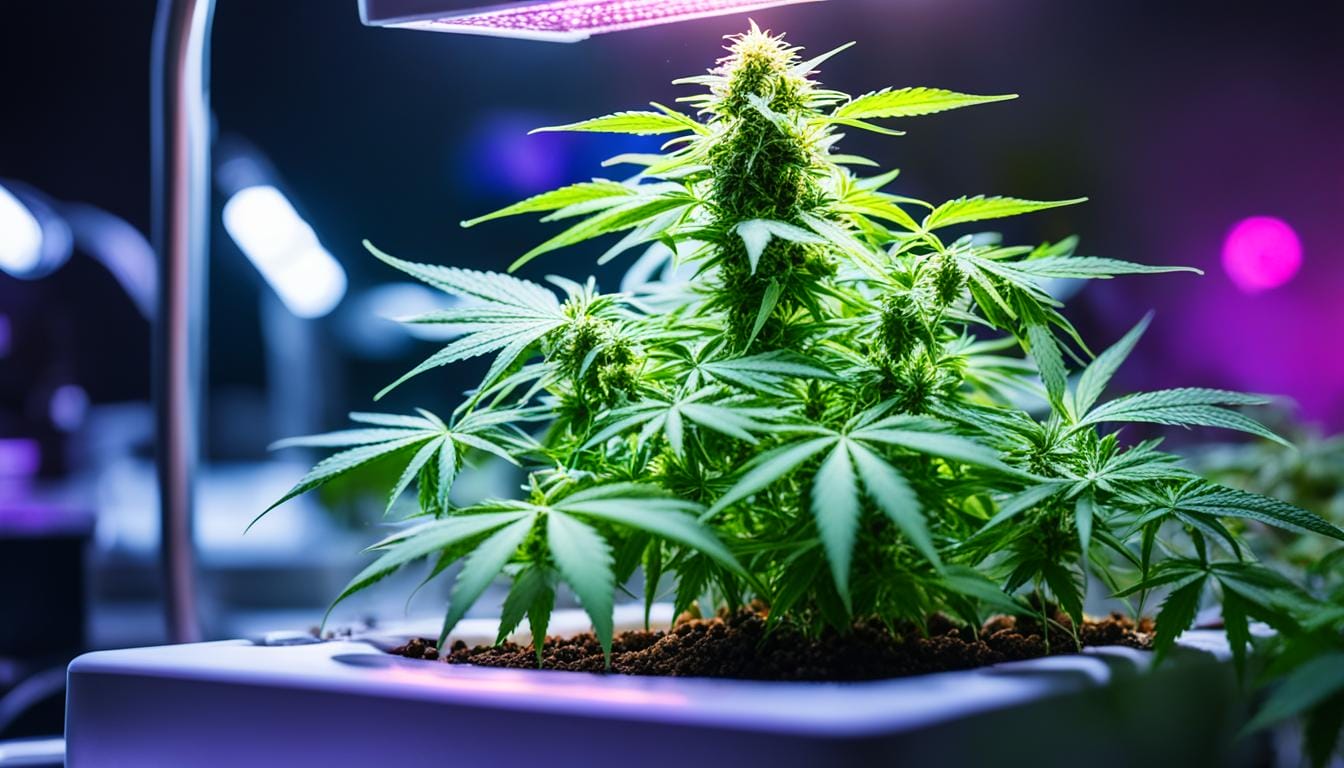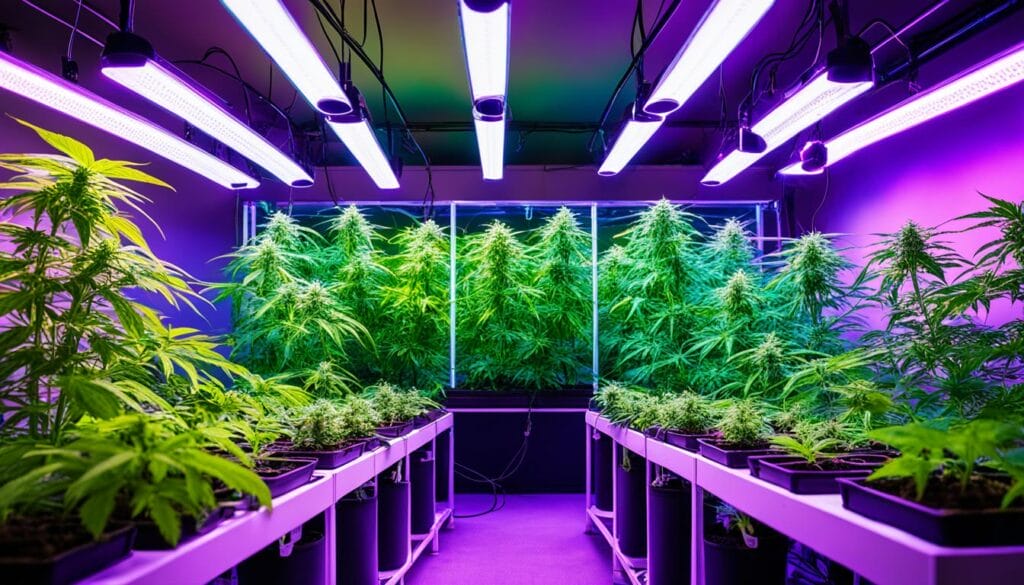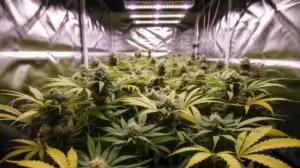Grow Lights for Cannabis Seeds: A Complete Guide

Growing cannabis at home requires the right setup. The quality of your grow lights is key to success. They can make or break your seeds’ early stages.
Sunlight is ideal for plants, but indoor growers must mimic its spectrum. The type of lighting greatly affects your plants’ growth stages, from germination to full growth. Lights are crucial for thriving cannabis indoors.
Join us as we explore grow lights for cannabis. Learn how they aid in strong germination and healthy growth. Get insights on tailoring your setup for the best start for your cannabis plants.
Key Takeaways
- Understanding the critical role grow lights play in cannabis seed germination and growth.
- Exploring the science behind light’s influence on indoor cannabis cultivation.
- Practical tips for selecting the right kind of grow lights for each stage of cannabis development.
- Insights into optimizing light conditions to align with the specific needs of cannabis seeds.
- Briefing on how innovative grow light technology applies to different cannabis varieties.
The Importance of Proper Lighting for Cannabis Seed Germination
Lighting schedules are crucial for growing cannabis successfully. The right light is a must, not just a nice-to-have for seeds. It affects how fast seeds sprout and their health. Knowing how light impacts germination is key.
Understanding the Role of Darkness in Cannabis Seed Germination
Many think seeds need light to start germinating. But they actually need darkness first. In the dark, seeds can wake up and begin to grow. This rest in the dark helps them gather energy to sprout.
Optimal Light Conditions Post-Sprouting: The 18-Hour Light Cycle
After seeds sprout, they need the right light to grow well. They thrive under an 18-hour light cycle. This helps them make more food for growth. Setting up this light pattern helps young plants become strong.
| Germination Phase | Light Requirement | Recommended Duration |
|---|---|---|
| Initial Dark Period | Absence of Light (Darkness) | 24-72 hours |
| Post-Sprouting Growth | Consistent Light Exposure | 18-hour cycles |
Proper lighting is key to germination. A mix of dark and light phases is key. Following a strict light schedule boosts germination and growth.
Different Types of Grow Lights for Cannabis
Choosing the right grow lights is crucial for growing cannabis. There are many kinds of lights available. Growers must know about the different types to use them well. The main lights for cannabis include LED (Light Emitting Diode), HID (High-Intensity Discharge), Fluorescent lights like CFL (Compact Fluorescent Light) and T5, and Metal Halide/High-Pressure Sodium bulbs.
Each light type offers unique benefits for plant growth. They can impact how fast plants grow and how much they flower. To help choose, let’s look at what makes each one special:
- LED lights save a lot of energy and last a long time. They now provide a wide range of light, perfect for all cannabis growth stages.
- HID lamps, including Metal Halide and High-Pressure Sodium, give off bright light that helps plants grow strong. However, they use more energy and heat up a lot.
- Fluorescent lights, especially T5 bulbs, are great for young plants. They give enough light without too much heat, which is good for small plants.
Since cannabis plants need different light at different times, using a mix of grow lights works best. Now, let’s compare some of their features:
| Light Type | Energy Efficiency | Heat Emission | Spectrum Range | Lifespan |
|---|---|---|---|---|
| LED | High | Low | Full | 50,000-100,000 hours |
| HID | Moderate | High | Varies with Bulb Type | 10,000-18,000 hours |
| Fluorescent (CFL, T5) | Low to Moderate | Low | Limited | 7,000-15,000 hours |
There are many grow lights for cannabis, and each has improved over time. Knowing how they work helps growers pick the right light for healthy plants.
The final choice in lighting depends on budget, space, and goals. As new advances come along, growers have more ways to get great results.
Maximizing Seed Growth: Intensity and Spectrum Considerations
Understanding the link between light intensity and spectrum is key for growing healthy cannabis seedlings. The correct balance significantly impacts plant health and yield. Here, we’ll explore how light intensity, seen in Photosynthetically Active Radiation (PAR) and Photosynthetic Photon Flux Density (PPFD), is crucial for both the vegetative and flowering phases of cannabis growth.
PAR and PPFD: Measuring Light Intensity for Seedlings
PAR is the light plants use for photosynthesis, covering 400 to 700 nanometers. This light’s intensity helps plants turn light into chemical energy. PPFD measures how much PAR hits the plant each second, in micromoles per square meter per second (µmol/m²/s). Knowing these helps growers fine-tune their lights for the best seed growth.

Understanding Light Temperature for Vegetative and Flowering Stages
Light temperature, in Kelvin, affects plants in the vegetative and flowering stages differently. Cooler light, similar to the spring sun and rich in blue, helps with tight node spacing and leaf growth. Warmer light mirrors the autumn sun, with more red, which is great for budding and fruiting.
| Stage of Growth | Preferred Light Spectrum | Light Temperature (Kelvin) | PPFD Range (µmol/m²/s) |
|---|---|---|---|
| Vegetative | Blue Spectrum | 5000K – 6500K | 200 – 400 |
| Flowering | Red Spectrum | 2200K – 3000K | 400 – 700 |
Adjusting light temperature and light intensity can hugely impact your cannabis plants’ flowering stage and yield. It’s about replicating natural conditions to boost seed growth. This optimization can make your cannabis plants thrive and produce a bountiful harvest.
Choosing the Right Grow Light for Your Seeds: LED vs. CFL
If you’re into indoor gardening, especially with cannabis seeds, picking the right grow light is crucial. LED (Light Emitting Diode) and CFL (Compact Fluorescent Light) lights are top picks. Each has its own benefits and downsides that affect plant growth and how much you spend over time.
Pros and Cons of LED and CFL Lights for Indoor Gardening
LED lights are known for their energy-saving feature and durability. They produce a light spectrum that can be adjusted for your plants’ needs. Plus, they don’t give off much heat, reducing the risk of harming your plants. But, the upfront cost for LED lights is more than CFLs, which could be a downside for some.
On the other hand, CFLs cost less and are easy to find. They are a go-to for new gardeners or those with small projects because they’re simple to use. However, they don’t last as long as LEDs, and their light range isn’t as plant-friendly at all stages of growth.
Here’s a quick comparison between LED and CFL grow lights:
| Feature | LED | CFL |
|---|---|---|
| Initial Cost | Higher | Lower |
| Energy Efficiency | More efficient | Less efficient |
| Lifespan | Longer (up to 25,000 hours) | Shorter (about 8,000 hours) |
| Heat Emission | Low | High |
| Spectrum | Customizable for stages of growth | Fixed, less targeted |
| Suitability | Ideal for all growth stages | Best for initial growth stages |
Consider the pros and cons when deciding what’s best for your plants. Some start with CFLs for their price and later switch to LEDs for better growth and savings.
Calculating the Cost-Efficiency of Various Grow Lights
Looking at cost-efficiency in indoor gardening is about more than just the price of the lights. You need to think about how much they cost to run, how much power they use, and how often they need replacing. Figuring out the real value includes thinking about long-term costs, like electricity bills and replacements.
Though pricier at first, an LED light saves money and energy in the long run. CFLs may be cheaper initially, but they use more power and need replacing sooner, raising their long-term costs.
Finding the real cost can be tricky, but it’s a key part of choosing wisely. Use online calculators to help, considering wattage, how often you use them, electricity rates, and life expectancy. Picking the right grow light can mean healthier plants and more savings.
When comparing LED to CFL for indoor gardening, going with the most sustainable and efficient option makes sense. It matches long-term growing goals and is kinder to the planet. While both options can work at the start, your specific situation will guide you to the best choice for lighting your indoor garden.
Setting Up Your Grow Lights: Placement and Distance Strategies
Properly setting up grow lights is crucial for effective indoor gardening. This means considering both placement and distance strategies. Getting this right ensures your plants grow strong and yield well. Follow this guide for the best way to place and distance your grow lights.
First, understand your growing area. It’s key to spread light evenly across all plants. This might mean using more lights or reflectors to avoid shadows and reach the lower leaves. The distance of lights from plants is equally crucial. Too close, they might burn the leaves. Too far, and your plants could grow tall and weak as they stretch towards the light.
Keep in mind, the best distance between grow lights and plants changes as they grow. Young seedlings need softer light, while mature plants need brighter light.
- Do not place lights over paths to avoid making shadows.
- Start with the height suggested by the light makers, then adjust for your plant types.
- Turn plants often so all sides get equal light.
Here is a table showing general light placement and distances for different plant stages:
| Growth Stage | Light Type | Placement | Distance from Canopy |
|---|---|---|---|
| Seedling | Fluorescent, Lower-Wattage LED | Directly above plants | 24-36 inches |
| Vegetative | Full-Spectrum LED, MH | Slightly off-center for even coverage | 18-24 inches |
| Flowering | HPS, High-Intensity LED | Directly above plants | 12-18 inches |
Use these placement and distance tips when setting up grow lights for a thriving indoor garden. Always watch how your plants react and adjust as needed. Your plants will grow better and healthier for it.
Top Grow Lights on the Market Reviewed: Spider Farmer and HLG Options
As indoor farming grows, finding the right lights is key to better crops. We’re looking at two top brands: Spider Farmer and HLG. Both are known for their great performance and reliability.

Spider Farmer SF Series: Budget-Friendly and Efficient
The Spider Farmer SF Series offers good value and uses less energy. It’s a favorite for those who want to save money and still get great results.
- Energy-efficient LED technology that minimizes electricity costs
- Full spectrum lighting for different growth stages
- Quiet operation due to fanless design
- Solid construction with waterproof components
Horticulture Lighting Group: Leading the Way in Yield Improvement
HLG is all about improving yields with its advanced lights. Their high-tech solutions are perfect for serious growers who focus on quality.
- High-intensity output for deeper canopy penetration
- Efficient heat management to safeguard plant health
- Durable and long-lasting light fixtures
- Innovative designs that cater to commercial-scale operations
| Feature | Spider Farmer SF Series | Horticulture Lighting Group |
|---|---|---|
| Price Point | Budget-friendly | Premium |
| Efficiency | High | High |
| Yield Potential | Moderate | High |
| Spectrum | Full | Full, with emphasis on red for flowering |
| Cooling System | Fanless | Passive and active cooling options |
| Suitability | Home Growers | Professional/Commercial Growers |
Both Spider Farmer and HLG have top-rated grow lights loved by growers. Whether you choose Spider Farmer’s affordability or HLG’s high performance depends on your needs and budget.
Customizing Light Cycles for Autoflowering and Feminized Cannabis Seeds
Mastering the customizing light cycles for cannabis seeds can boost your harvest’s quality and yield. Autoflowering and feminized seeds demand different care for the best growth and strong plants.
Autoflowering cannabis seeds flower on their own, without needing light changes. They’re great for growers because they don’t need strict light times. Yet, to grow them well, they require 18 to 24 hours of light daily. This balance aids in photosynthesis and growth. It also affects the strength and types of cannabinoids.
Feminized cannabis seeds only make female plants, needing a specific light pattern. In the vegetative phase, they do well with 18 hours of light and 6 of dark. This simulates summer, leading to strong foliage. When flowering, reducing light to 12 hours and dark to 12 triggers blooming. It’s like they sense a seasonal change.
To show the different light needs for autoflowering and feminized seeds, here’s a table:
| Seed Type | Vegetative Stage | Flowering Stage | Benefits |
|---|---|---|---|
| Autoflowering | 18-24 hours light | 18-24 hours light (No change) | Less maintenance, faster harvests |
| Feminized | 18 hours light / 6 hours dark | 12 hours light / 12 hours dark | Higher yield, enhanced control over flowering |
In short, tailoring light cycles for different cannabis seeds is key for a great harvest. By grasping the needs of autoflowering and feminized seeds, you can set up the perfect growing conditions for your plants to flourish.
Troubleshooting Common Issues with Grow Lights and Cannabis Seedlings
Experienced growers know that troubleshooting keeps cannabis seedlings healthy. Problems with grow lights can manifest in various symptoms in the plants. Catching these issues early and fixing them is key to growing strong plants.
Identifying Symptoms of Inadequate Lighting
Spotting symptoms of poor lighting is the first step in improving cannabis seedling growth. If you see leggy stems, tiny leaves, or a pale green hue, your lights might be the problem.
Balancing Moisture and Temperature with Light Intensity
For cannabis seedlings to do well, you must balance moisture and temperature with the right light intensity. Keeping this balance helps create a perfect growing space and avoid stress that can hinder growth and health in young plants.
| Symptom | Possible Cause | Solution |
|---|---|---|
| Leggy Stems | Inadequate light intensity | Increase light source or move closer to the plants |
| Small Leaves | Low-quality light spectrum | Upgrade to full-spectrum LED lights |
| Light Green Coloration | Lack of light | Adjust light cycle to provide more hours of light |
| Drooping | High temperature or overwatering | Regulate temperature and reduce watering frequency |
| Yellowing Leaves | High moisture or inadequate drainage | Ensure proper soil drainage and control humidity levels |
Cannabis Seeds: Sourcing and Selection for Optimal Growth with Grow Lights
For enthusiasts and cultivators looking to ensure optimal growth of their cannabis plants, the choice of cannabis seeds is key. The right seeds lay the groundwork for a great harvest, especially with suitable grow lights. So, how do you pick the best seeds for your indoor setup?
Start by finding reputable seed banks known for their quality. These places offer superior seeds that germinate well, leading to healthy plants and more yield. Selection isn’t just about genetics; it involves picking the right strain for your grow lights. Each strain may behave differently under various lights, making this choice essential.
Here’s a guideline to aid your selection process:
- Research strains known for responding well to indoor cultivation.
- Read reviews and gather feedback from other growers about their experiences with specific strains under grow lights.
- Consider the size and growth habits of the strain to ensure compatibility with your space and lighting setup.
As cultivators, we aim for efficiency and sustainability. The best sourcing and selection techniques help us achieve optimal growth. This is especially true when combined with top-notch grow lights.
Here’s a helpful comparison of different seed strains and their compatibility with various types of grow lights:
| Strain Name | Light Type Compatibility | Expected Yield (indoors) | Growth Difficulty |
|---|---|---|---|
| Blue Dream | LED, HPS | High | Moderate |
| OG Kush | LED, CFL | Moderate | Challenging |
| White Widow | HPS, MH | High | Easy |
| Sour Diesel | CFL, LED | High | Moderate |
Sourcing and selection are vital for growers. Aligning these with a good grow light setup paves the way for optimal growth. This ensures better yield, potency, and overall satisfaction in gardening.
Conclusion
In our journey, we learned that growing healthy cannabis plants needs attention to every detail. This includes choosing the right grow light and understanding light cycles for different seeds. We’ve shared tips on using grow lights effectively, from sprouting seeds to growing strong plants. The right light leads to healthy growth and more yield.
Choosing the right lights, like LED or CFL, is crucial. So is knowing about PAR and PPFD or how to position your lights. These aren’t small details; they’re key to indoor gardening success. We looked at top products from Spider Farmer and Horticulture Lighting Group. Quality gear can really make a difference. Yet, using that gear well is what truly matters.
We urge you to use what you’ve learned here in your garden. Think about what we said regarding picking and finding the best cannabis seeds. Good seeds and the right light settings will boost your cannabis growth. With everything we’ve covered, you’re set to improve your gardening. Follow these guidelines, and you’ll see rewarding, brilliant results.
FAQs
What is the importance of proper lighting for cannabis seed germination?
Proper lighting gives cannabis seeds the energy to start growing. It’s also key for the young plants as they grow.
How does darkness affect cannabis seed germination?
Darkness is needed for seeds to begin growing. It releases certain hormones. These hormones help seeds germinate successfully.
What are the optimal light conditions required for the post-sprouting growth of cannabis seeds?
After sprouting, cannabis seeds need 18 hours of light and 6 hours of dark each day. This cycle helps them grow well.
What are the different types of grow lights available for cannabis cultivation?
LED, CFL, and HID lights are commonly used to grow cannabis. Each type offers unique features and advantages for growing cannabis.
How can light intensity and spectrum influence seed growth?
Light intensity and spectrum greatly affect how seeds grow. The right balance of these can impact stages like vegetative and flowering.
What is the difference between LED and CFL lights for growing cannabis?
LED lights save energy and stay cool. They can also be adjusted to specific light needs. However, CFL lights are less expensive and produce more heat, so proper airflow is needed. Your choice depends on your own grow needs and budget.
How can I calculate the cost-efficiency of different grow lights?
For cost efficiency, look at the initial price, power use, life span, and upkeep. Then, pick the grow light that offers the best value for your setup.
What are some placement and distance strategies for setting up grow lights?
Proper placement and distance from the plants prevent too much or too little light. It varies with the light type and power.
Which are the top grow lights on the market?
Top choices include Spider Farmer SF Series for budget efficiency and HLG for boosting yields. Both are known for their performance.
How can light cycles be customized for autoflowering and feminized cannabis seeds?
Autoflowering and feminized seeds have unique light needs. Providing the right light mix is crucial for their best growth.
What are some common issues with grow lights and cannabis seedlings?
Poor lighting can cause slow growth, stretching, and changes in leaf color. It’s important to fix lighting problems quickly.
How can I source and select high-quality cannabis seeds for optimal growth with grow lights?
Choose well-known seed banks with top-notch, organic seeds. Look at genetics, reviews, and the bank’s reputation to find the best seeds for your indoor setup.
Suggested Articles
;)
;)
;)




 14 Nov 2025
14 Nov 2025  9 min read
9 min read


 April 07, 2025
April 07, 2025 


RESPONSES (0)
No responses yet. Be the first to respond!